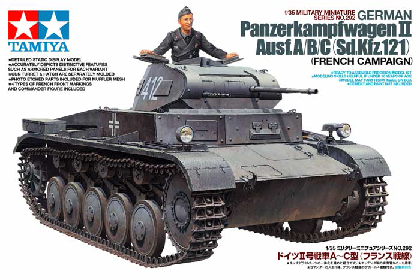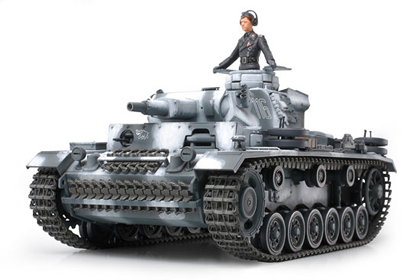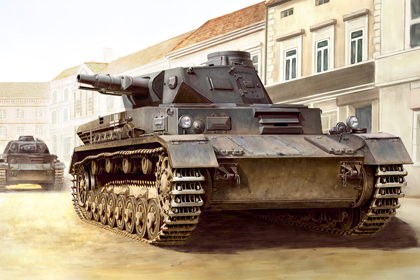This is the Tamiya 35292-3200 kit in 1/35 scale, of the ‘German Panzerkampfwagen II Ausf. A/B/C (French Campaign)’.

This is the Tamiya 35292-3200 kit in 1/35 scale, of the ‘German Panzerkampfwagen II Ausf. A/B/C (French Campaign)’.

This is the Tamiya 35 374-4000 kit in 1/35 scale, of the ‘German Panzerkampfwagen IV, Ausf. F’.

In service throughout WWII, the Pz.Kpfw.IV was a durable servant to the German Army.
The Ausf. F was the last variant to utilize a short-barreled gun: the L/24 7.5cm KwK37, and was also equipped with wider tracks to cope with the increasing thicknesses of armor.
470 Ausf. F Pz.Kpfw.IVs were manufactured between May 1941 and February 1942, mainly seeing action on the Eastern Front and in North Africa and taking on enemy armor such as the Soviet KV tanks and the British Matilda.
Source: Tamiya website
This is the Tamiya 35 353 kit in 1/35 scale, of the ‘German Brummbär (Late production)’.

Developed for infantry support during WWII, the Assault Tank IV married the trusty Pz.Kpfw.IV chassis with a simple fighting compartment featuring 100mm of front and 50mm of side armor, plus a high-powered 15cm gun that could defeat 160mm of 30-degree armor from 5km.
Its variants can largely be grouped into early, mid and late production types, the latter of which was most numerous with 160 examples manufactured between May 1944 and March 1945. Feedback from crews of earlier Brummbärs had led to new a fighting compartment design and cupola, plus partial use of steel road wheels.
Brummbärs were assigned to their own dedicated Assault Tank Battalions and fought on the Eastern Front and in Italy as the war drew to its conclusion.
Source: Tamiya website
This is the Tamiya 35 290-3600 kit in 1/35 scale, of the ‘German Panzerkampfwagen III, Ausf. N’.

From June 1942 through to August 1943, existing J, L, & M models also received these upgrades and 663 tanks were fitted, and another 37 were also upgraded later in 1944. In the summer of 1942 these tanks appeared on the battlefield with their highly explosive shells, and they proved to be highly efficient in their role of reinforcing the ground troops.
They were deployed into newly organized heavy tank battalions, to make up for the lack of Tiger I tanks. As a support tank, the N type was easy to manage and very reliable, and in the latter half of WWII it fought at many fronts.
This is the MiniArt 35169 kit in 1/35 scale, of the ‘German Pz.Kpfw.III Ausf. D’.

The official German designation was Panzerkampfwagen III Sd.Kfz.141 (abbreviated Pz.Kpfw.III) translating as “armoured fighting vehicle”. It was intended to fight other armoured fighting vehicles and serve alongside the infantry support Panzer IV.
From 1942, the last version of Panzer III mounted the 7.5 cm KwK 37 L/24, better suited for infantry support. Production of the Panzer III ended in 1943. However, the Panzer III’s capable chassis provided hulls for the Sturmgeschütz III assault gun until the end of the war.
This is the Trumpeter 09542 kit in 1/35 scale, of the ‘German Super Heavy StuG E-100’.

Work on E-tanks was abandoned before the end of WWII.
This is the HobbyBoss 80132 kit in 1/35 scale, of the ‘German Pz.Kpfw.IV Ausf. D/Tauch’.

On August 19, 1940 there were 152 Panzer III and 48 Panzer IV in all ready for the four special Panzer units. After “Operation Sealion” was given up, the vehicles divided among Eutin, Putlos, Bremen and Hamburg were almost all assigned to the 18th Panzer Division.
The Tauchpanzer IV D were converted for the underwater version. Additional sealing was provided for the engine air-intakes, and the exhaust was fitting with non-return valves in place of the normal mufflers. The mantlet and MG mountings were all covered with waterproof fabric. The driver’s visor was made watertight by special metal cover with a visor block. An inflatable rubber tube was also used to seal the turret ring.
This is the Trumpeter 00367 kit in 1/35 scale, of the ‘German Panzerkampfwagen, KV-2 754(r)’.

The KV-2 characteristic is its quick-fried tower shape. The quick-fried tower that equip 152 millimeters of howitzers reports the hexagon keeps the square form, resembling an enormous box.
One of the (sturm) Panzerkampfwagen KV-II 754(r) of Panzerkompanie(z.b.v) 66 with the commander’s cupola of a Panzerkampfwagen III G/IV EE and stowage racks for the 152mm ammunition on the rear hull.
This is the HobbyBoss 80130 kit in 1/35 scale, of the ‘German Pz.Kpfw.IV Ausf. C’.

Designed as an infantry-support tank, the Panzer IV was not originally intended to engage enemy armor — that function was performed by the lighter Panzer III. However, with the flaws of pre-war doctrine becoming apparent and in the face of Soviet T-34 tanks, the Panzer IV soon assumed the tank-fighting role of its increasingly obsolete cousin.
The most widely manufactured and deployed German tank of the Second World War, the Panzer IV was used as the base for many other fighting vehicles, including the Sturmgeschütz IV assault gun, Jagdpanzer IV tank destroyer, the Wirbelwind self-propelled anti-aircraft weapon, and the Brummbär self-propelled gun.
This is the HobbyBoss 80131 kit in 1/35 scale, of the ‘German Pz.Kpfw.IV Ausf. B’.

Designed as an infantry-support tank, the Panzer IV was not originally intended to engage enemy armor — that function was performed by the lighter Panzer III. However, with the flaws of pre-war doctrine becoming apparent and in the face of Soviet T-34 tanks, the Panzer IV soon assumed the tank-fighting role of its increasingly obsolete cousin.
The most widely manufactured and deployed German tank of the Second World War, the Panzer IV was used as the base for many other fighting vehicles, including the Sturmgeschütz IV assault gun, Jagdpanzer IV tank destroyer, the Wirbelwind self-propelled anti-aircraft weapon, and the Brummbär self-propelled gun.
This is the MiniArt 35162 kit in 1/35 scale, of the ‘German Pz.Kpfw.III Ausf. C’.

The Ausf. C still had eight road wheels on each side, with the first and last pairs on a short leaf spring, mounted parallel to the ground. The second and third pairs were supported by a longer leaf-spring assembly. Also featured were a servo-operated epicyclic clutch, brake steering and a new design for the drive sprocket and idler.
By 20 January 1938 there were only twenty-three Pz.Kpfw.III in the total Army Inventory. But this number had increased to forty-two by the end of March 1938. The Ausf. C saw action only in Poland. It was withdrawn from Panzer regiments in February 1940, before the start of the campaign in the West.
This is the Dragon 6713 kit in 1/35 scale, of the ‘German s.IG.33 auf Fahrgestell Pz.Kpfw.III’.

Five crewmen operated this self-propelled gun that was used exclusively on the Eastern Front. Half fought in the bloody Battle of Stalingrad from October 1942 onwards, where their heavy guns could effectively demolish buildings in the bitter urban combat.
The remaining vehicles didn’t reach Stalingrad because the German 6th Army was encircled by that time, so instead they deployed with the 23rd Panzer Division.